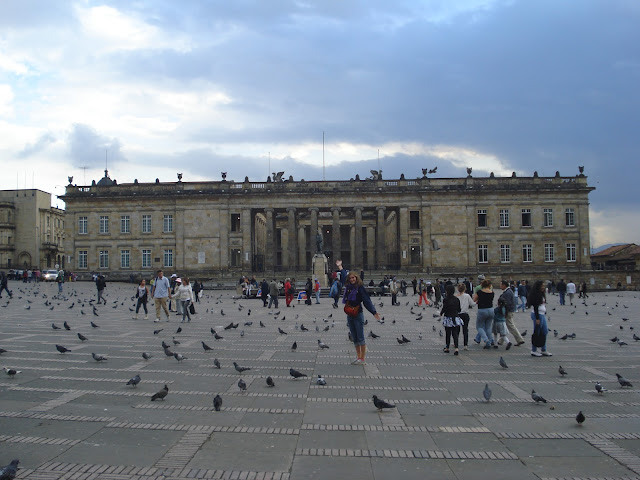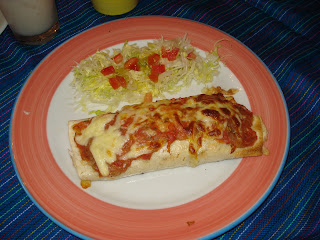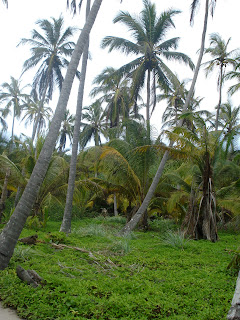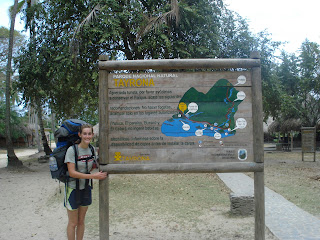One of our very last stops on our trip was Parque Nacional Tayrona in Colombia. I had been looking forward to this part of the trip since we started planning. Partly because it just looked gorgeous in the photos and sounded amazing in the travel book, and partly because everyone who we met told us it was just astounding. It definitely lived up to my expectations. It was the perfect, beach paradise I had been waiting for the entire trip (well, Ecuador did a pretty good job fulfilling that roll as well). Tranquil, no city, no cars, just pure, untouched, paradise. I have a thing for national parks, they just never seem to disappoint. Lots of outdoor activities and beautiful scenery, two of my favorite things.
Anyways, we first had a brief stopover in Taganga, a cute little beach town that is the launching point (along with the it's bigger next door neighbor, Santa Marta) for going to the park. There are a couple of options for getting there: bussing from town and then hiking (which takes a good amount of time), taxi to the park entrance then hiking, taxi to the park entrance then horses, or boating. We did a little bit of everything. On our way there, we decided to take the boat because it went straight from Tangaga to the part of the park where we wanted to stay (which, if you go by land is the farthest beach away, but if you go by boat, is the closest).

Here is the bay at Tanganga. We went in one of those little boats. The water looks nice and calm, right? WRONG. I had NO IDEA the the Caribbean Sea could be SO choppy! In the bays, it's pretty calm, but as soon as you head to "open sea" (if that's possible in the Caribbean), there are some gigantic waves. Or so they seem when you're in a tiny little boat, they probably actually weren't that big. Luckily, only one person in our boat got sea sick and it wasn't Maya or me. And, she wasn't sitting next to me haha. I had wanted to have my camera out to take pictures along the way, but the driver really stressed that we should stow EVERYTHING except for ourselves in the covered part of the boat because things tended to get wet. He wasn't exaggerating. When we got off the boat it looked like we had been swimming in the sea with our clothes on, instead of just on a boat. It was kind of fun, but after about an hour of it, I was ready to just be there and stop thumping down from waves. However, it was all worth it because we saw these little guys:

Flying fish! I had never seen them before (at least that I can remember). When I first saw them jumping next to the boat I had no idea what they were. But then I started looking closer and I realized that they were fish, flying next to us. Usually they jumped out in groups, otherwise they would have been really hard to see because the blended almost perfectly with the color of the water. However, whenever we would crash off of another wave, I would lose site and have to keep a close look out to find another group. When we pulled up to our stopping point we saw something like this (we were actually one pay over, so it was a little more populated because it's where everyone camps):

This is the beach that was about a 5 minute walk away from the campground. It was awesome. Serene, beautiful, nice water. We spent a lot of time here, enjoying swimming in the water, reading, journaling and taking in the scenery. I think I could have stayed here forever, it's pretty much my definition of perfect.
Perfect blue water, perfect green trees, perfect off-white sand, and my dress awkwardly hanging off the tree...all untouched by urbanization. This is just a small snapshot of the natural beauty that we saw. And, as usual, the camera definitely doesn't do it enough justice. But, at least it can give you some sort of idea.

One thing everyone had warned us about was food. There's only one restaurant at the campground and it's really expensive, plus there's no place to cook. So, before we left Tanganga, Maya and I loaded up on foods we could make without cooking. We got pretty creative, I was impressed. With our planning ahead, we only had to eat one meal per day in the restaurant (we figured it would be nice to have one proper meal per day) and it also made it a lot easier to wander around during the day, because we never had to come back to the restaurant to eat, we could just take some food with us. However, we did occasionally splurge on these delicious fresh fruit juices. I fell in love with them. I'm convinced that they would go out into the jungle in the morning and pick the fruits to make juice later on that afternoon. My other favorite part of the restaurant was journaling at the tables when it was closed (the kitchen was only open during certain hours, but the tables were always out). Every evening when we got back from our daily adventure we would pick the one that was closest to the beach so we could have the best view of the sea and hear the soft crash of the waves. There was no internet or anything like that, so it was just us, whoever we decided to talk to that night, our journals and our books. Quite a relief, sometimes, to be cut off from the rest of the world. There is a lot less responsibility involved :)

Now, here's one of the interesting parts of Tayrona: the main sleeping accommodations are the hammocks pictured above. I had heard a lot of mixed reviews about them from other travelers. The main general consensus tended to be that they were fun for the first night, okay for two nights, and after that you really needed to find some other accommodations. Well, we spent two nights and three days in the park. Both of our nights were spent in the hammocks. We tried to get a tent, because they were supposedly a lot more comfortable, but they were all reserved. So, to the hammocks it was! They weren't too bad, I definitely prefer them for day-time lounging, but it did the trick for sleeping. We, luckily, had our sleeping bags. A lot of people didn't think to bring something warm to wrap up in at night because they assumed that because it was hot and humid during the day, it was going to be the same at night. Not the case, it definitely cooled off. However, Maya and I stayed nice and toasty in our sleeping bags. The other downside were the bugs. They liked to attack us while we were sleeping. So we took to putting bug spray on our faces right before we went to sleep and making sure the rest of our bodies were inside our sleeping bags; it ended up being a fairly effective strategy.

One of the days, I went on a walk along the beaches. What I hadn't realized was that each little bay had it's own little "development" (aka, tents and usually some sort of indoor accommodations as well as a little restaurant). Ours was the known cheap backpackers beach. And, in my opinion, it was the nicest. Not to say the rest of the coastline wasn't equally as stunning. Every time I came out into another bay I was awed by the landscape. And, during the inland parts, it was hiking through forests of palm trees. Above is a little slice of one of the beaches.
This is what the palm tree forest look like...so green!
 |
One of the days, we decided to take a hike up to the village of Pueblito. Both of us thought that it was an indigenous village that was still populated, not so, it was an abandoned village. The ruins were somewhat unimpressive compared to everything we had seen in Peru. However, it was still fun to see them. And, the hike up to the village was awesome. It was pure jungle, with some great ocean views along the way. It was pretty tiring, because it was straight up hill the whole way. And, there were some parts we had to pretty creative about how we were going to continue because there would be a couple of giant boulders that we would have to climb over. Plus, it was hot and humid out, not exactly the most desirable climate for going for a long hike in. Along the way there were little trail markers that would tell us how much we had walked and how much we had left to walk, which was kind of nice. We had heard some stories about people getting robbed on the path, so we decided to leave our cameras and other valuables at camp. Except, of course, we both brought a little bit of money to hand over the robbers should we happen to be caught in the situation (we tried to come up on what was the right amount to bring. How much is too little, so they will get mad and hurt you anyways? But how much is too much, because obviously we don't want to give them more than necessary. I think we ended up settling at about $20 each). Luckily, we had no problems. Oh, and our water of course. However, we also had no pictures, so I stole these ones from google (thank you, world wide web). One of the most exciting parts of the trip (apart from the blue footed boobies...I have an animal thing) was seeing a little anteater! In the wild! I had only seen the giant anteater before in zoos. But, apparently they come in all shapes and sizes and colors. Another guy who was making the hike explained to us that it was the normal size for that species (we thought it might be a baby), and they lived in the park. I think we were pretty fortunate to be able to see it, I don't think too many people get that opportunity. We stood watching it for about 10 minutes (it was up on a tree branch, hanging out and eating), before it finally ran way in the trees. It was a nice little break from our hike and a nice gift from nature. |

After not too terribly long, we ended up at Pueblito (we ended up passing quite a few people on the way up. It think it was all of our high altitude hiking training). It was mostly the ruins of some little round houses, some with thatched roofs, and little stone path running through the middle of it. We took advantage of arriving at the village to take a short break and drink some water and eat a little snack. Then, we decided to go back down the other way, to make a full circle loop instead of seeing the same thing on the way down (plus, I'm not really sure how we would have scaled some of the boulders the opposite way). The way down was equally as jungly and beautiful. However, we ended on the nudist beach (which, we had forewarning about because other tourists have kindly graffitied on the signs leading down to that beach, things to the effect of CAREFUL: WAY TO NUDIST BEACH). The beach was beautiful, and hung out for a while (fully clothed), but then decided to head back to camp and go to the non-nudist beach to enjoy a little bit more beach time. During the hike, we also saw a ton of different species of butterflies. They were all brightly colored and beautiful. I remembered we counted how many different kinds, but now I can't remember, I think it was something like 8, just in a half-day hike.

On the way back to Taganga, we decided to take the hiking route out. The majority of it is along the bays, passing through the different camp areas. It was absolutely beautiful. I'm glad we decided to do it that way, because we got to see a lot of the park and enjoy the last bit of beach. Luckily, the hostel where we were staying in Taganga had let us leave some of our stuff there, so we only had to bring the necessities and valuables, making it a much more pleasant backpacking trip.
The Welcome to Parque Nacional Tyrona sign, complete with a little map of all the camps.
The first site that you pass by if entering by land (for us, the last sight before the trek out to the highway), is by far the most upscale. It has little cabins with electricity, bathrooms that supply toilet paper (in our camp you had to bring your own, thank goodness someone warned us of that. Although, by that point in the summer I was used to carrying a role with me wherever I went because a lot of bathrooms do not supply it) and two restaurants to pick form, as well as food stands. Pretty classy for the middle of nowhere (and I even think it was "eco-friendly"). After the beach part was a jungle trek out to the road. However, once we rounded the bend from the bays onto the last stretch, we saw that there were some horses available. We decided to take advantage of their services. It was quite interesting trying to ride the horses with our giant backpacks, but we made it work. It took us about an hour to get out on horseback, so I can't imagine how long it would have taken us hiking (although, the owner of the horses jogged along side us the whole time, pretty impressive). It was a nice green, shady ride, and we saw some cool critters along the way.


Maya and me on our respective horses. Mine wanted to be the leader. From the back, it just look like our backpacks were riding the horses.

Once we arrived at the stopping point of the horses, we realized there was about another 30-45 minute walk to get out the main road and catch the bus. However, some other people had just arrived at the park in a taxi, so we decided to take that back to Tanganga rather than walking and then riding the bus. There was a bit of a misunderstanding about how much it would cost, but everything worked out okay and we made it safely back to the hostel. Of course, when we got back, the whole town was without power. We thought it would be a temporary few-hour thing, but it ended up lasting until about 11pm that night, by which time I was fast asleep, so I didn't even realize it until the next morning. However, we still had fun. During the day, we went down to the little beach in town (which was just so, inadequate, after being in the park) because it was really hot, but since there was no electricity, there were no fans. So, we took advantage of being close to the water and went swimming to escape the heat. At nighttime, we enjoyed the hostel by candlelight and most of the restaurants down by the beach had generators so we were able to eat.

While we were down at the beach we saw a few of these guys swimming around: sea slugs. The ones we saw were brown-ish, though, not green like this one. They were kind of creepy and kind of cool all at the same time. The little kids, who ended becoming our best friends on the beach, or so they thought haha, were running through the water trying to catch them, sometimes actually being successful.
After an amazing couple of days in Tanganga and Parque Nacional Tyrona, we were off to our last destination of the trip: Bogotá. We flew from Santa Marta to Bogotá, which I'm very glad about, I only heard horror stories about how long and miserable the bus ride was. So...that's up next!


















































